Effectiveness of Standard Costing in Cost Control: South East Toyota
VerifiedAdded on 2022/08/22
|67
|21507
|24
Project
AI Summary
This dissertation examines the effectiveness of the standard costing system implemented at South East Toyota (Pvt) Ltd for cost control within the motor industry. The study, conducted in 2015, explores the company's struggles to maximize profitability despite employing standard costing. The research investigates issues such as inappropriate implementation, leading to employee retrenchment, technological stagnation, customer loss, and pricing challenges. The study recommends establishing a standards committee, encouraging employee involvement in standards setting, and improving communication to enhance profitability. The research utilizes both primary data from questionnaires and interviews, and secondary data analysis to present its findings, which highlight the relationship between standard costing and cost control, the difficulties faced in cost management, and the consequences of cost increases. It concludes with recommendations for improving cost control and maximizing profitability through a refined standard costing system.
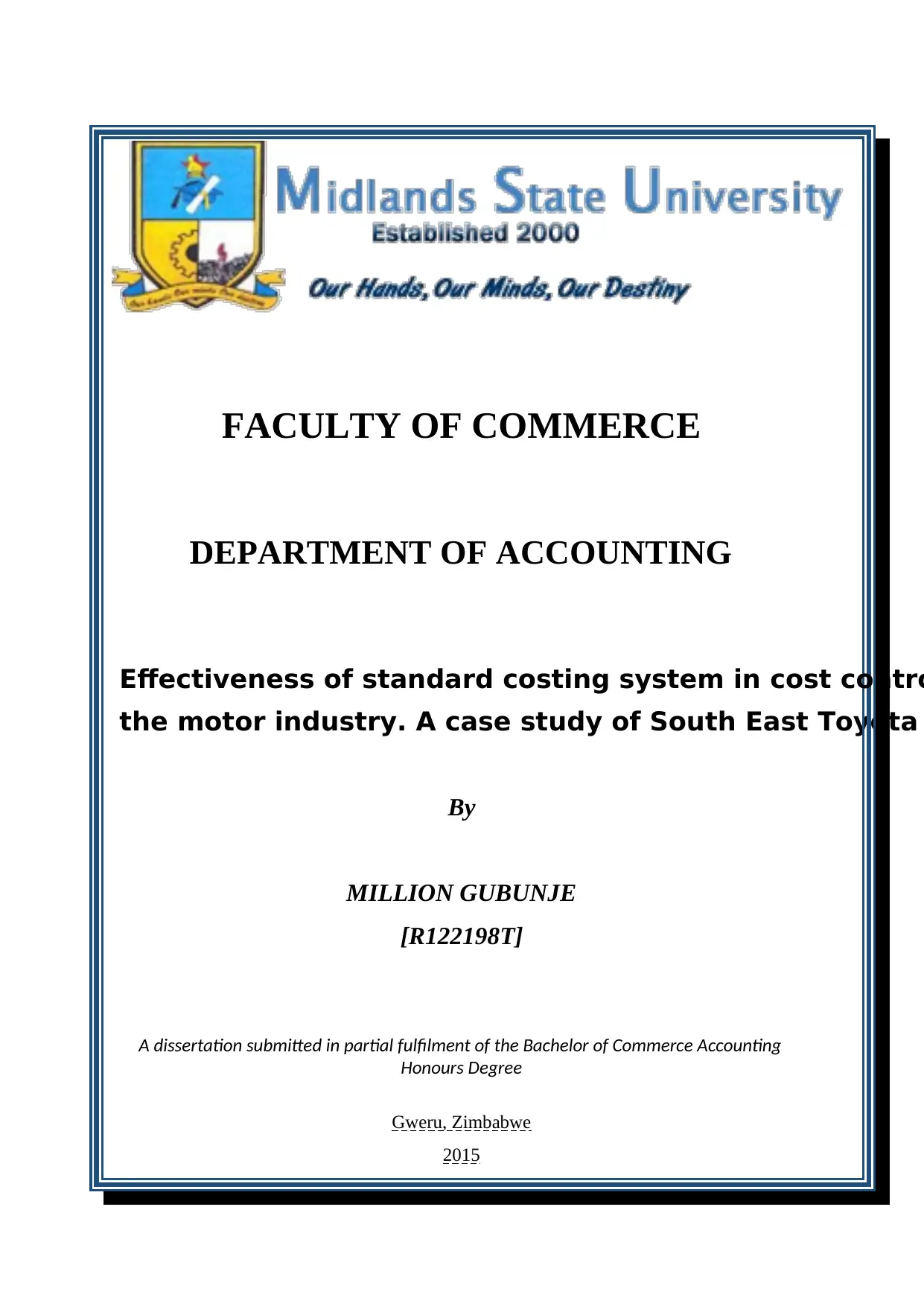
FACULTY OF COMMERCE
DEPARTMENT OF ACCOUNTING
Effectiveness of standard costing system in cost contro
the motor industry. A case study of South East Toyota
By
MILLION GUBUNJE
[R122198T]
A dissertation submitted in partial fulfilment of the Bachelor of Commerce Accounting
Honours Degree
Gweru, Zimbabwe
2015
DEPARTMENT OF ACCOUNTING
Effectiveness of standard costing system in cost contro
the motor industry. A case study of South East Toyota
By
MILLION GUBUNJE
[R122198T]
A dissertation submitted in partial fulfilment of the Bachelor of Commerce Accounting
Honours Degree
Gweru, Zimbabwe
2015
Paraphrase This Document
Need a fresh take? Get an instant paraphrase of this document with our AI Paraphraser
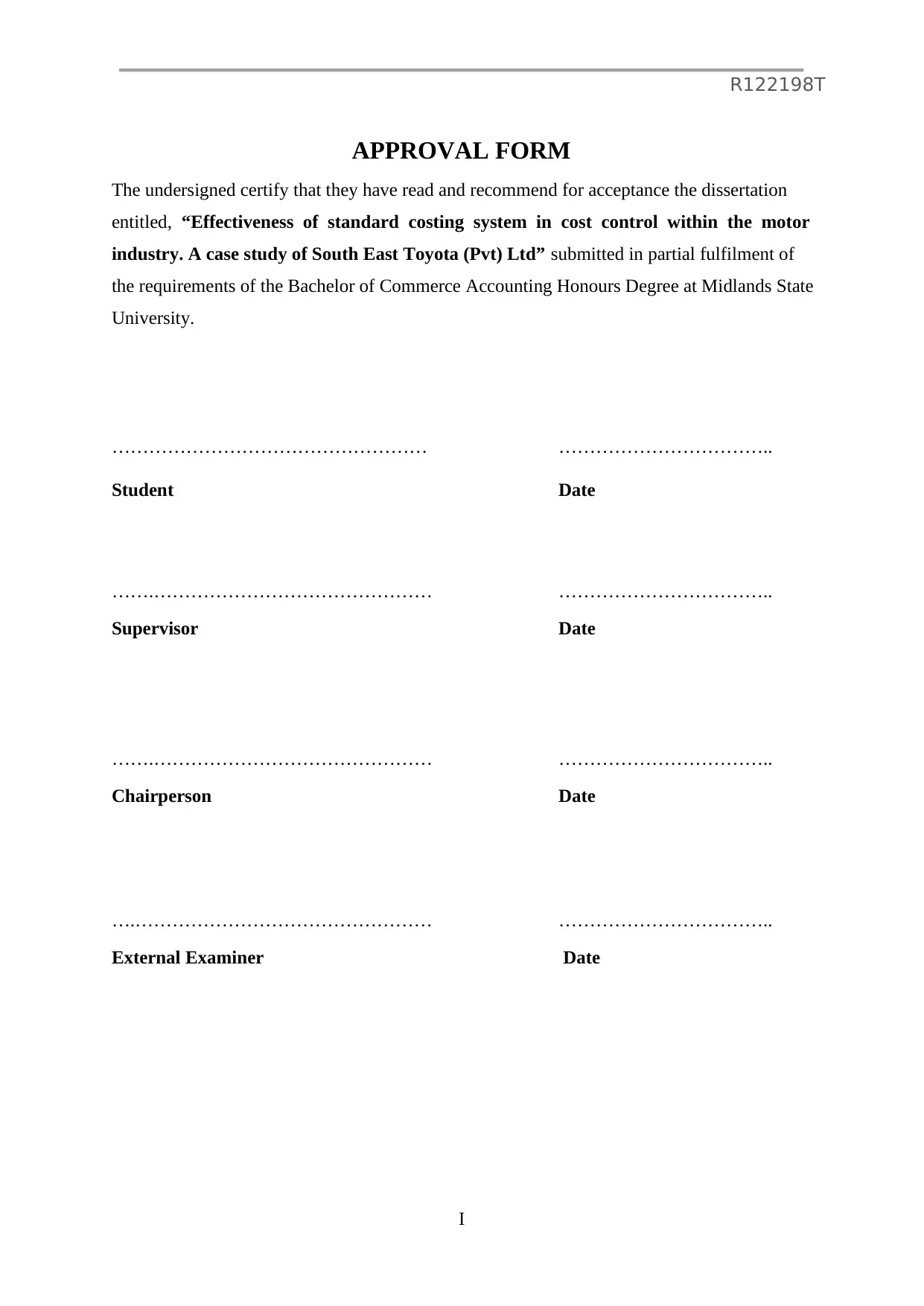
R122198T
I
APPROVAL FORM
The undersigned certify that they have read and recommend for acceptance the dissertation
entitled, “Effectiveness of standard costing system in cost control within the motor
industry. A case study of South East Toyota (Pvt) Ltd” submitted in partial fulfilment of
the requirements of the Bachelor of Commerce Accounting Honours Degree at Midlands State
University.
…………………………………………… ……………………………..
Student Date
…….……………………………………… ……………………………..
Supervisor Date
…….……………………………………… ……………………………..
Chairperson Date
….………………………………………… ……………………………..
External Examiner Date
I
APPROVAL FORM
The undersigned certify that they have read and recommend for acceptance the dissertation
entitled, “Effectiveness of standard costing system in cost control within the motor
industry. A case study of South East Toyota (Pvt) Ltd” submitted in partial fulfilment of
the requirements of the Bachelor of Commerce Accounting Honours Degree at Midlands State
University.
…………………………………………… ……………………………..
Student Date
…….……………………………………… ……………………………..
Supervisor Date
…….……………………………………… ……………………………..
Chairperson Date
….………………………………………… ……………………………..
External Examiner Date
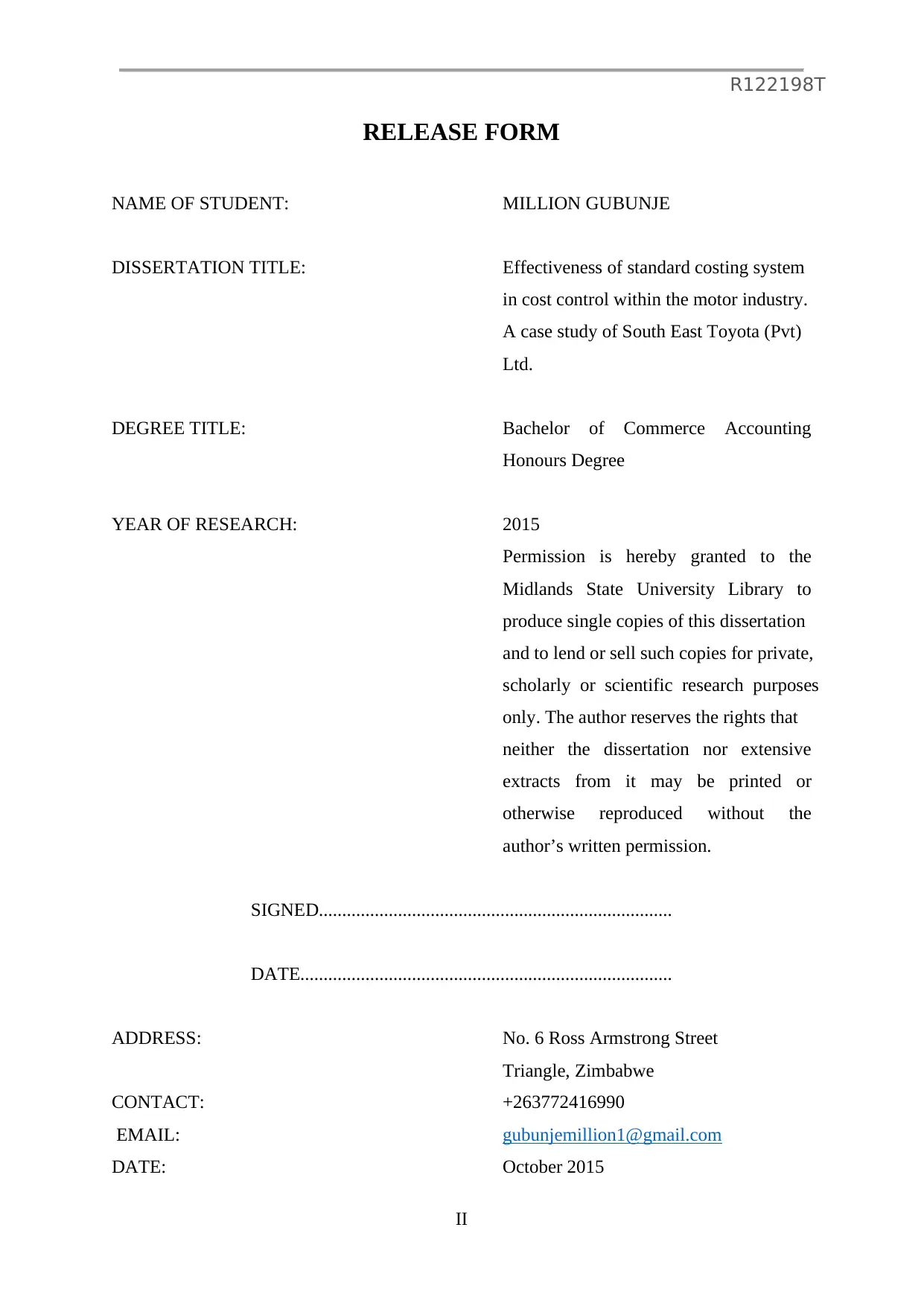
R122198T
II
RELEASE FORM
NAME OF STUDENT: MILLION GUBUNJE
DISSERTATION TITLE: Effectiveness of standard costing system
in cost control within the motor industry.
A case study of South East Toyota (Pvt)
Ltd.
DEGREE TITLE: Bachelor of Commerce Accounting
Honours Degree
YEAR OF RESEARCH: 2015
Permission is hereby granted to the
Midlands State University Library to
produce single copies of this dissertation
and to lend or sell such copies for private,
scholarly or scientific research purposes
only. The author reserves the rights that
neither the dissertation nor extensive
extracts from it may be printed or
otherwise reproduced without the
author’s written permission.
SIGNED............................................................................
DATE................................................................................
ADDRESS: No. 6 Ross Armstrong Street
Triangle, Zimbabwe
CONTACT: +263772416990
EMAIL: gubunjemillion1@gmail.com
DATE: October 2015
II
RELEASE FORM
NAME OF STUDENT: MILLION GUBUNJE
DISSERTATION TITLE: Effectiveness of standard costing system
in cost control within the motor industry.
A case study of South East Toyota (Pvt)
Ltd.
DEGREE TITLE: Bachelor of Commerce Accounting
Honours Degree
YEAR OF RESEARCH: 2015
Permission is hereby granted to the
Midlands State University Library to
produce single copies of this dissertation
and to lend or sell such copies for private,
scholarly or scientific research purposes
only. The author reserves the rights that
neither the dissertation nor extensive
extracts from it may be printed or
otherwise reproduced without the
author’s written permission.
SIGNED............................................................................
DATE................................................................................
ADDRESS: No. 6 Ross Armstrong Street
Triangle, Zimbabwe
CONTACT: +263772416990
EMAIL: gubunjemillion1@gmail.com
DATE: October 2015
⊘ This is a preview!⊘
Do you want full access?
Subscribe today to unlock all pages.

Trusted by 1+ million students worldwide
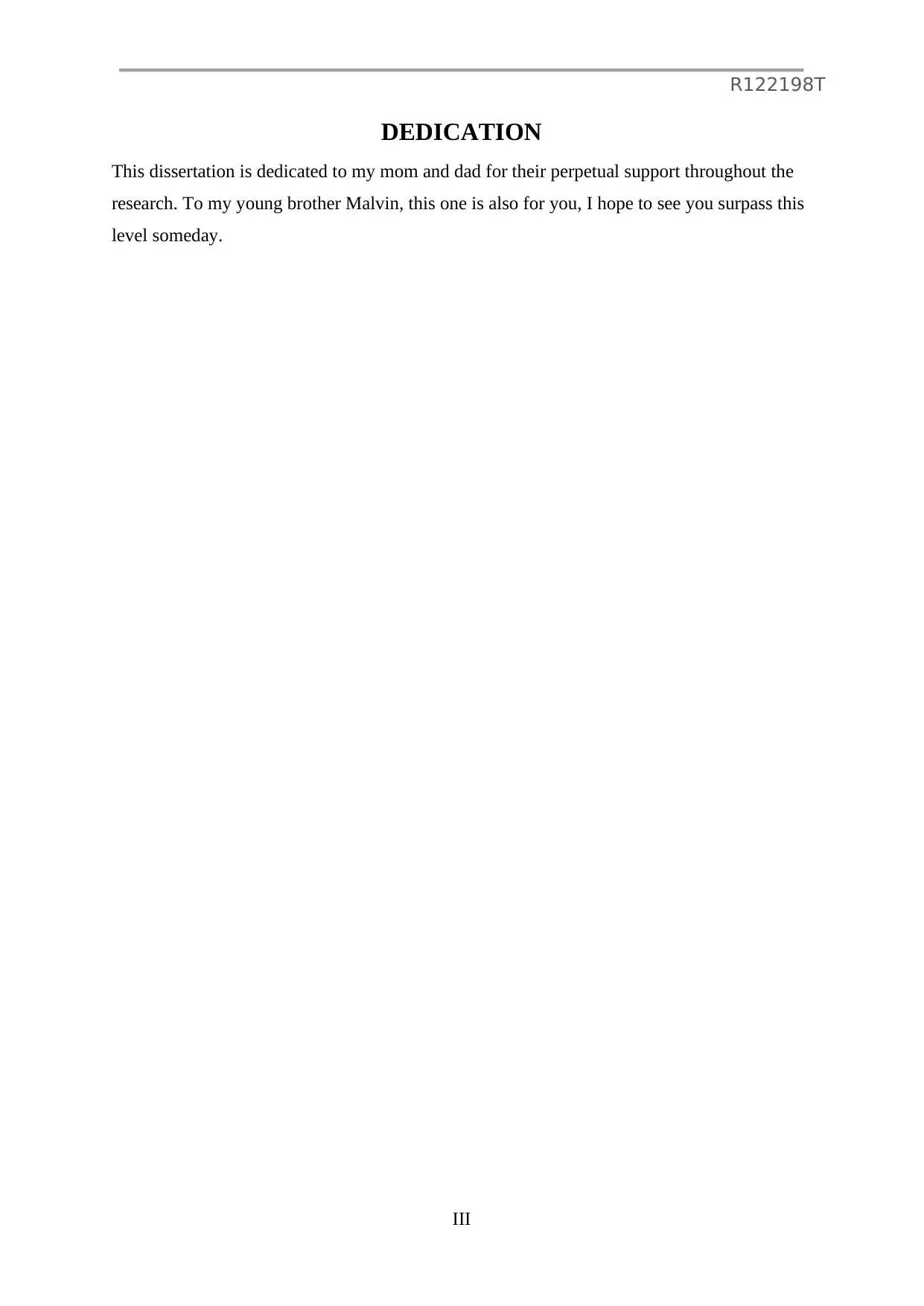
R122198T
III
DEDICATION
This dissertation is dedicated to my mom and dad for their perpetual support throughout the
research. To my young brother Malvin, this one is also for you, I hope to see you surpass this
level someday.
III
DEDICATION
This dissertation is dedicated to my mom and dad for their perpetual support throughout the
research. To my young brother Malvin, this one is also for you, I hope to see you surpass this
level someday.
Paraphrase This Document
Need a fresh take? Get an instant paraphrase of this document with our AI Paraphraser
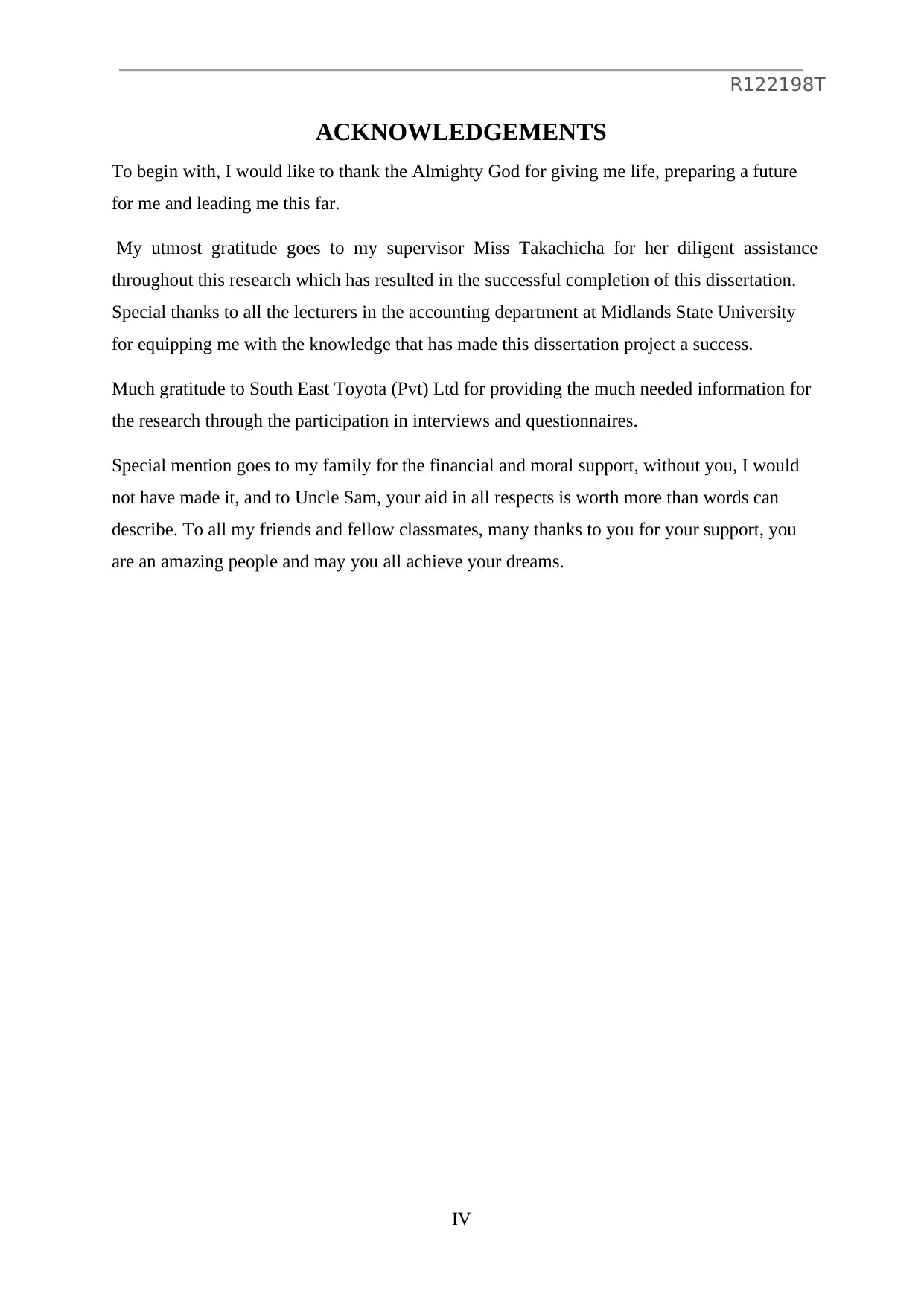
R122198T
IV
ACKNOWLEDGEMENTS
To begin with, I would like to thank the Almighty God for giving me life, preparing a future
for me and leading me this far.
My utmost gratitude goes to my supervisor Miss Takachicha for her diligent assistance
throughout this research which has resulted in the successful completion of this dissertation.
Special thanks to all the lecturers in the accounting department at Midlands State University
for equipping me with the knowledge that has made this dissertation project a success.
Much gratitude to South East Toyota (Pvt) Ltd for providing the much needed information for
the research through the participation in interviews and questionnaires.
Special mention goes to my family for the financial and moral support, without you, I would
not have made it, and to Uncle Sam, your aid in all respects is worth more than words can
describe. To all my friends and fellow classmates, many thanks to you for your support, you
are an amazing people and may you all achieve your dreams.
IV
ACKNOWLEDGEMENTS
To begin with, I would like to thank the Almighty God for giving me life, preparing a future
for me and leading me this far.
My utmost gratitude goes to my supervisor Miss Takachicha for her diligent assistance
throughout this research which has resulted in the successful completion of this dissertation.
Special thanks to all the lecturers in the accounting department at Midlands State University
for equipping me with the knowledge that has made this dissertation project a success.
Much gratitude to South East Toyota (Pvt) Ltd for providing the much needed information for
the research through the participation in interviews and questionnaires.
Special mention goes to my family for the financial and moral support, without you, I would
not have made it, and to Uncle Sam, your aid in all respects is worth more than words can
describe. To all my friends and fellow classmates, many thanks to you for your support, you
are an amazing people and may you all achieve your dreams.
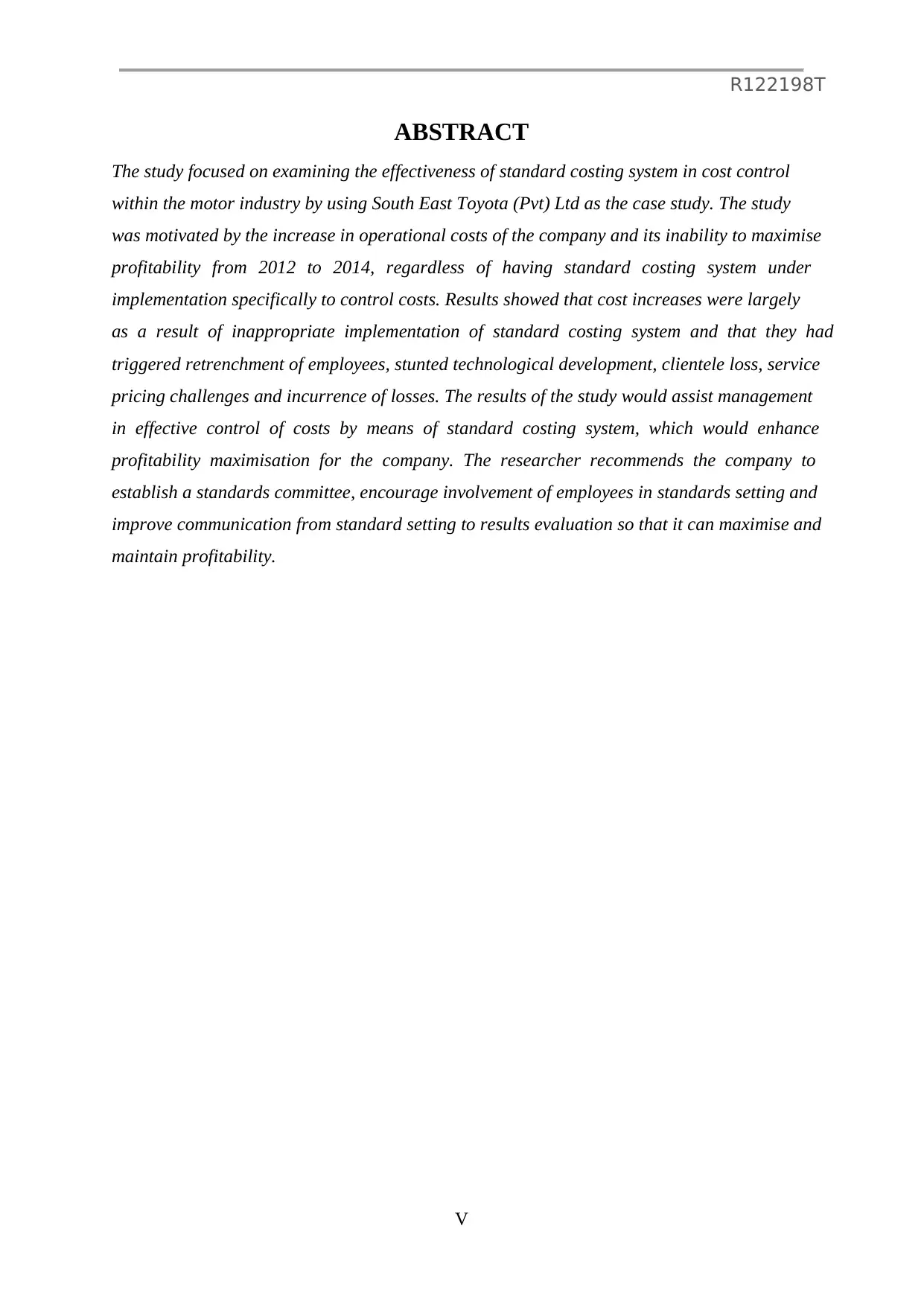
R122198T
V
ABSTRACT
The study focused on examining the effectiveness of standard costing system in cost control
within the motor industry by using South East Toyota (Pvt) Ltd as the case study. The study
was motivated by the increase in operational costs of the company and its inability to maximise
profitability from 2012 to 2014, regardless of having standard costing system under
implementation specifically to control costs. Results showed that cost increases were largely
as a result of inappropriate implementation of standard costing system and that they had
triggered retrenchment of employees, stunted technological development, clientele loss, service
pricing challenges and incurrence of losses. The results of the study would assist management
in effective control of costs by means of standard costing system, which would enhance
profitability maximisation for the company. The researcher recommends the company to
establish a standards committee, encourage involvement of employees in standards setting and
improve communication from standard setting to results evaluation so that it can maximise and
maintain profitability.
V
ABSTRACT
The study focused on examining the effectiveness of standard costing system in cost control
within the motor industry by using South East Toyota (Pvt) Ltd as the case study. The study
was motivated by the increase in operational costs of the company and its inability to maximise
profitability from 2012 to 2014, regardless of having standard costing system under
implementation specifically to control costs. Results showed that cost increases were largely
as a result of inappropriate implementation of standard costing system and that they had
triggered retrenchment of employees, stunted technological development, clientele loss, service
pricing challenges and incurrence of losses. The results of the study would assist management
in effective control of costs by means of standard costing system, which would enhance
profitability maximisation for the company. The researcher recommends the company to
establish a standards committee, encourage involvement of employees in standards setting and
improve communication from standard setting to results evaluation so that it can maximise and
maintain profitability.
⊘ This is a preview!⊘
Do you want full access?
Subscribe today to unlock all pages.

Trusted by 1+ million students worldwide
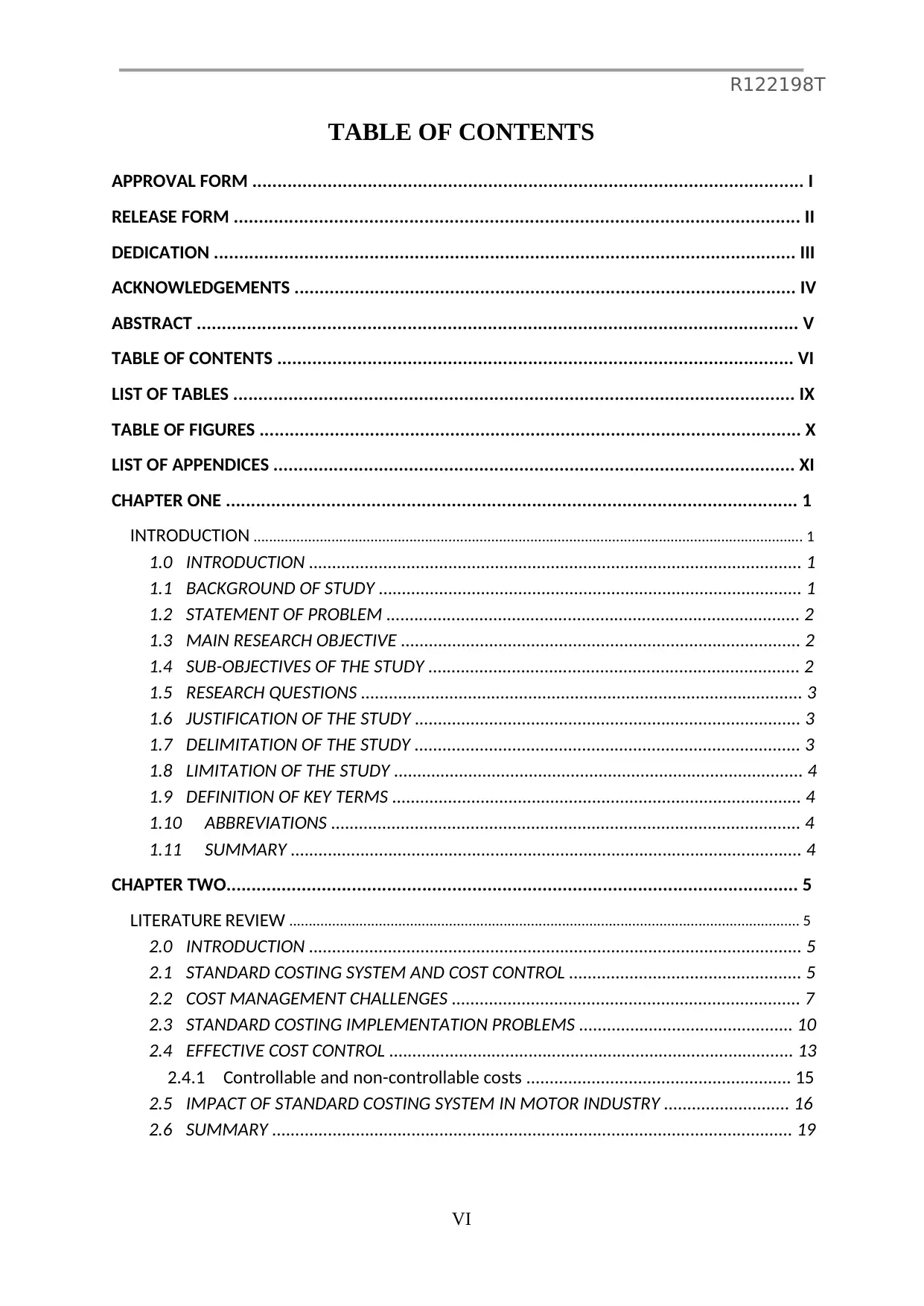
R122198T
VI
TABLE OF CONTENTS
APPROVAL FORM .............................................................................................................. I
RELEASE FORM ................................................................................................................. II
DEDICATION .................................................................................................................... III
ACKNOWLEDGEMENTS .................................................................................................... IV
ABSTRACT ........................................................................................................................ V
TABLE OF CONTENTS ....................................................................................................... VI
LIST OF TABLES ................................................................................................................ IX
TABLE OF FIGURES ............................................................................................................ X
LIST OF APPENDICES ........................................................................................................ XI
CHAPTER ONE .................................................................................................................. 1
INTRODUCTION ............................................................................................................................................. 1
1.0 INTRODUCTION .......................................................................................................... 1
1.1 BACKGROUND OF STUDY ........................................................................................... 1
1.2 STATEMENT OF PROBLEM ......................................................................................... 2
1.3 MAIN RESEARCH OBJECTIVE ...................................................................................... 2
1.4 SUB-OBJECTIVES OF THE STUDY ................................................................................ 2
1.5 RESEARCH QUESTIONS ............................................................................................... 3
1.6 JUSTIFICATION OF THE STUDY ................................................................................... 3
1.7 DELIMITATION OF THE STUDY ................................................................................... 3
1.8 LIMITATION OF THE STUDY ........................................................................................ 4
1.9 DEFINITION OF KEY TERMS ........................................................................................ 4
1.10 ABBREVIATIONS ..................................................................................................... 4
1.11 SUMMARY .............................................................................................................. 4
CHAPTER TWO.................................................................................................................. 5
LITERATURE REVIEW ................................................................................................................................... 5
2.0 INTRODUCTION .......................................................................................................... 5
2.1 STANDARD COSTING SYSTEM AND COST CONTROL .................................................. 5
2.2 COST MANAGEMENT CHALLENGES ........................................................................... 7
2.3 STANDARD COSTING IMPLEMENTATION PROBLEMS .............................................. 10
2.4 EFFECTIVE COST CONTROL ....................................................................................... 13
2.4.1 Controllable and non-controllable costs ......................................................... 15
2.5 IMPACT OF STANDARD COSTING SYSTEM IN MOTOR INDUSTRY ........................... 16
2.6 SUMMARY ................................................................................................................ 19
VI
TABLE OF CONTENTS
APPROVAL FORM .............................................................................................................. I
RELEASE FORM ................................................................................................................. II
DEDICATION .................................................................................................................... III
ACKNOWLEDGEMENTS .................................................................................................... IV
ABSTRACT ........................................................................................................................ V
TABLE OF CONTENTS ....................................................................................................... VI
LIST OF TABLES ................................................................................................................ IX
TABLE OF FIGURES ............................................................................................................ X
LIST OF APPENDICES ........................................................................................................ XI
CHAPTER ONE .................................................................................................................. 1
INTRODUCTION ............................................................................................................................................. 1
1.0 INTRODUCTION .......................................................................................................... 1
1.1 BACKGROUND OF STUDY ........................................................................................... 1
1.2 STATEMENT OF PROBLEM ......................................................................................... 2
1.3 MAIN RESEARCH OBJECTIVE ...................................................................................... 2
1.4 SUB-OBJECTIVES OF THE STUDY ................................................................................ 2
1.5 RESEARCH QUESTIONS ............................................................................................... 3
1.6 JUSTIFICATION OF THE STUDY ................................................................................... 3
1.7 DELIMITATION OF THE STUDY ................................................................................... 3
1.8 LIMITATION OF THE STUDY ........................................................................................ 4
1.9 DEFINITION OF KEY TERMS ........................................................................................ 4
1.10 ABBREVIATIONS ..................................................................................................... 4
1.11 SUMMARY .............................................................................................................. 4
CHAPTER TWO.................................................................................................................. 5
LITERATURE REVIEW ................................................................................................................................... 5
2.0 INTRODUCTION .......................................................................................................... 5
2.1 STANDARD COSTING SYSTEM AND COST CONTROL .................................................. 5
2.2 COST MANAGEMENT CHALLENGES ........................................................................... 7
2.3 STANDARD COSTING IMPLEMENTATION PROBLEMS .............................................. 10
2.4 EFFECTIVE COST CONTROL ....................................................................................... 13
2.4.1 Controllable and non-controllable costs ......................................................... 15
2.5 IMPACT OF STANDARD COSTING SYSTEM IN MOTOR INDUSTRY ........................... 16
2.6 SUMMARY ................................................................................................................ 19
Paraphrase This Document
Need a fresh take? Get an instant paraphrase of this document with our AI Paraphraser
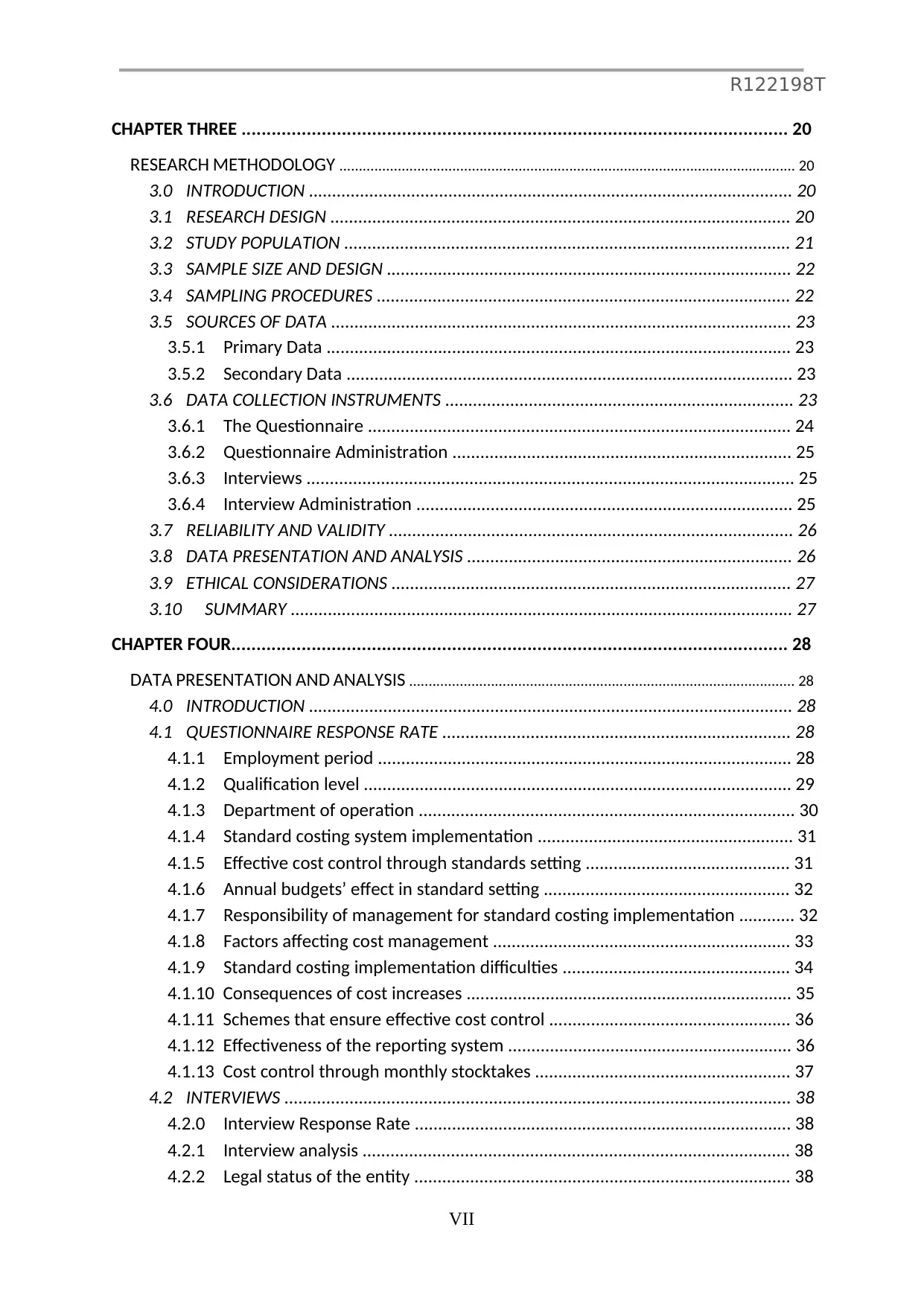
R122198T
VII
CHAPTER THREE ............................................................................................................. 20
RESEARCH METHODOLOGY ..................................................................................................................... 20
3.0 INTRODUCTION ........................................................................................................ 20
3.1 RESEARCH DESIGN ................................................................................................... 20
3.2 STUDY POPULATION ................................................................................................ 21
3.3 SAMPLE SIZE AND DESIGN ....................................................................................... 22
3.4 SAMPLING PROCEDURES ......................................................................................... 22
3.5 SOURCES OF DATA ................................................................................................... 23
3.5.1 Primary Data .................................................................................................... 23
3.5.2 Secondary Data ................................................................................................ 23
3.6 DATA COLLECTION INSTRUMENTS ........................................................................... 23
3.6.1 The Questionnaire ........................................................................................... 24
3.6.2 Questionnaire Administration ......................................................................... 25
3.6.3 Interviews ......................................................................................................... 25
3.6.4 Interview Administration ................................................................................. 25
3.7 RELIABILITY AND VALIDITY ....................................................................................... 26
3.8 DATA PRESENTATION AND ANALYSIS ...................................................................... 26
3.9 ETHICAL CONSIDERATIONS ...................................................................................... 27
3.10 SUMMARY ............................................................................................................ 27
CHAPTER FOUR............................................................................................................... 28
DATA PRESENTATION AND ANALYSIS ................................................................................................... 28
4.0 INTRODUCTION ........................................................................................................ 28
4.1 QUESTIONNAIRE RESPONSE RATE ........................................................................... 28
4.1.1 Employment period ......................................................................................... 28
4.1.2 Qualification level ............................................................................................ 29
4.1.3 Department of operation ................................................................................. 30
4.1.4 Standard costing system implementation ....................................................... 31
4.1.5 Effective cost control through standards setting ............................................ 31
4.1.6 Annual budgets’ effect in standard setting ..................................................... 32
4.1.7 Responsibility of management for standard costing implementation ............ 32
4.1.8 Factors affecting cost management ................................................................ 33
4.1.9 Standard costing implementation difficulties ................................................. 34
4.1.10 Consequences of cost increases ...................................................................... 35
4.1.11 Schemes that ensure effective cost control .................................................... 36
4.1.12 Effectiveness of the reporting system ............................................................. 36
4.1.13 Cost control through monthly stocktakes ....................................................... 37
4.2 INTERVIEWS ............................................................................................................. 38
4.2.0 Interview Response Rate ................................................................................. 38
4.2.1 Interview analysis ............................................................................................ 38
4.2.2 Legal status of the entity ................................................................................. 38
VII
CHAPTER THREE ............................................................................................................. 20
RESEARCH METHODOLOGY ..................................................................................................................... 20
3.0 INTRODUCTION ........................................................................................................ 20
3.1 RESEARCH DESIGN ................................................................................................... 20
3.2 STUDY POPULATION ................................................................................................ 21
3.3 SAMPLE SIZE AND DESIGN ....................................................................................... 22
3.4 SAMPLING PROCEDURES ......................................................................................... 22
3.5 SOURCES OF DATA ................................................................................................... 23
3.5.1 Primary Data .................................................................................................... 23
3.5.2 Secondary Data ................................................................................................ 23
3.6 DATA COLLECTION INSTRUMENTS ........................................................................... 23
3.6.1 The Questionnaire ........................................................................................... 24
3.6.2 Questionnaire Administration ......................................................................... 25
3.6.3 Interviews ......................................................................................................... 25
3.6.4 Interview Administration ................................................................................. 25
3.7 RELIABILITY AND VALIDITY ....................................................................................... 26
3.8 DATA PRESENTATION AND ANALYSIS ...................................................................... 26
3.9 ETHICAL CONSIDERATIONS ...................................................................................... 27
3.10 SUMMARY ............................................................................................................ 27
CHAPTER FOUR............................................................................................................... 28
DATA PRESENTATION AND ANALYSIS ................................................................................................... 28
4.0 INTRODUCTION ........................................................................................................ 28
4.1 QUESTIONNAIRE RESPONSE RATE ........................................................................... 28
4.1.1 Employment period ......................................................................................... 28
4.1.2 Qualification level ............................................................................................ 29
4.1.3 Department of operation ................................................................................. 30
4.1.4 Standard costing system implementation ....................................................... 31
4.1.5 Effective cost control through standards setting ............................................ 31
4.1.6 Annual budgets’ effect in standard setting ..................................................... 32
4.1.7 Responsibility of management for standard costing implementation ............ 32
4.1.8 Factors affecting cost management ................................................................ 33
4.1.9 Standard costing implementation difficulties ................................................. 34
4.1.10 Consequences of cost increases ...................................................................... 35
4.1.11 Schemes that ensure effective cost control .................................................... 36
4.1.12 Effectiveness of the reporting system ............................................................. 36
4.1.13 Cost control through monthly stocktakes ....................................................... 37
4.2 INTERVIEWS ............................................................................................................. 38
4.2.0 Interview Response Rate ................................................................................. 38
4.2.1 Interview analysis ............................................................................................ 38
4.2.2 Legal status of the entity ................................................................................. 38
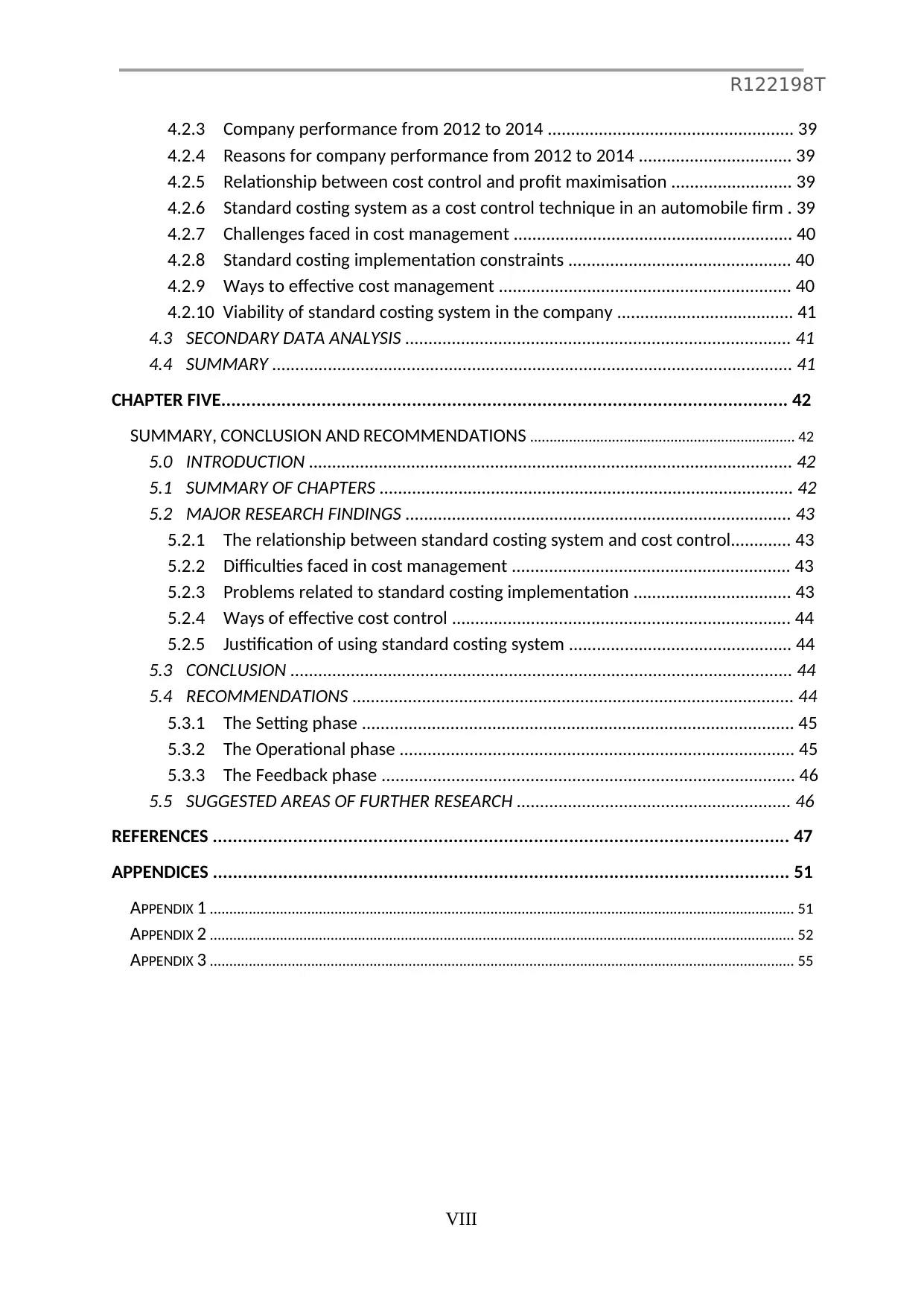
R122198T
VIII
4.2.3 Company performance from 2012 to 2014 ..................................................... 39
4.2.4 Reasons for company performance from 2012 to 2014 ................................. 39
4.2.5 Relationship between cost control and profit maximisation .......................... 39
4.2.6 Standard costing system as a cost control technique in an automobile firm . 39
4.2.7 Challenges faced in cost management ............................................................ 40
4.2.8 Standard costing implementation constraints ................................................ 40
4.2.9 Ways to effective cost management ............................................................... 40
4.2.10 Viability of standard costing system in the company ...................................... 41
4.3 SECONDARY DATA ANALYSIS ................................................................................... 41
4.4 SUMMARY ................................................................................................................ 41
CHAPTER FIVE................................................................................................................. 42
SUMMARY, CONCLUSION AND RECOMMENDATIONS .................................................................... 42
5.0 INTRODUCTION ........................................................................................................ 42
5.1 SUMMARY OF CHAPTERS ......................................................................................... 42
5.2 MAJOR RESEARCH FINDINGS ................................................................................... 43
5.2.1 The relationship between standard costing system and cost control............. 43
5.2.2 Difficulties faced in cost management ............................................................ 43
5.2.3 Problems related to standard costing implementation .................................. 43
5.2.4 Ways of effective cost control ......................................................................... 44
5.2.5 Justification of using standard costing system ................................................ 44
5.3 CONCLUSION ............................................................................................................ 44
5.4 RECOMMENDATIONS ............................................................................................... 44
5.3.1 The Setting phase ............................................................................................. 45
5.3.2 The Operational phase ..................................................................................... 45
5.3.3 The Feedback phase ......................................................................................... 46
5.5 SUGGESTED AREAS OF FURTHER RESEARCH ........................................................... 46
REFERENCES ................................................................................................................... 47
APPENDICES ................................................................................................................... 51
APPENDIX 1 ...................................................................................................................................................... 51
APPENDIX 2 ...................................................................................................................................................... 52
APPENDIX 3 ...................................................................................................................................................... 55
VIII
4.2.3 Company performance from 2012 to 2014 ..................................................... 39
4.2.4 Reasons for company performance from 2012 to 2014 ................................. 39
4.2.5 Relationship between cost control and profit maximisation .......................... 39
4.2.6 Standard costing system as a cost control technique in an automobile firm . 39
4.2.7 Challenges faced in cost management ............................................................ 40
4.2.8 Standard costing implementation constraints ................................................ 40
4.2.9 Ways to effective cost management ............................................................... 40
4.2.10 Viability of standard costing system in the company ...................................... 41
4.3 SECONDARY DATA ANALYSIS ................................................................................... 41
4.4 SUMMARY ................................................................................................................ 41
CHAPTER FIVE................................................................................................................. 42
SUMMARY, CONCLUSION AND RECOMMENDATIONS .................................................................... 42
5.0 INTRODUCTION ........................................................................................................ 42
5.1 SUMMARY OF CHAPTERS ......................................................................................... 42
5.2 MAJOR RESEARCH FINDINGS ................................................................................... 43
5.2.1 The relationship between standard costing system and cost control............. 43
5.2.2 Difficulties faced in cost management ............................................................ 43
5.2.3 Problems related to standard costing implementation .................................. 43
5.2.4 Ways of effective cost control ......................................................................... 44
5.2.5 Justification of using standard costing system ................................................ 44
5.3 CONCLUSION ............................................................................................................ 44
5.4 RECOMMENDATIONS ............................................................................................... 44
5.3.1 The Setting phase ............................................................................................. 45
5.3.2 The Operational phase ..................................................................................... 45
5.3.3 The Feedback phase ......................................................................................... 46
5.5 SUGGESTED AREAS OF FURTHER RESEARCH ........................................................... 46
REFERENCES ................................................................................................................... 47
APPENDICES ................................................................................................................... 51
APPENDIX 1 ...................................................................................................................................................... 51
APPENDIX 2 ...................................................................................................................................................... 52
APPENDIX 3 ...................................................................................................................................................... 55
⊘ This is a preview!⊘
Do you want full access?
Subscribe today to unlock all pages.

Trusted by 1+ million students worldwide
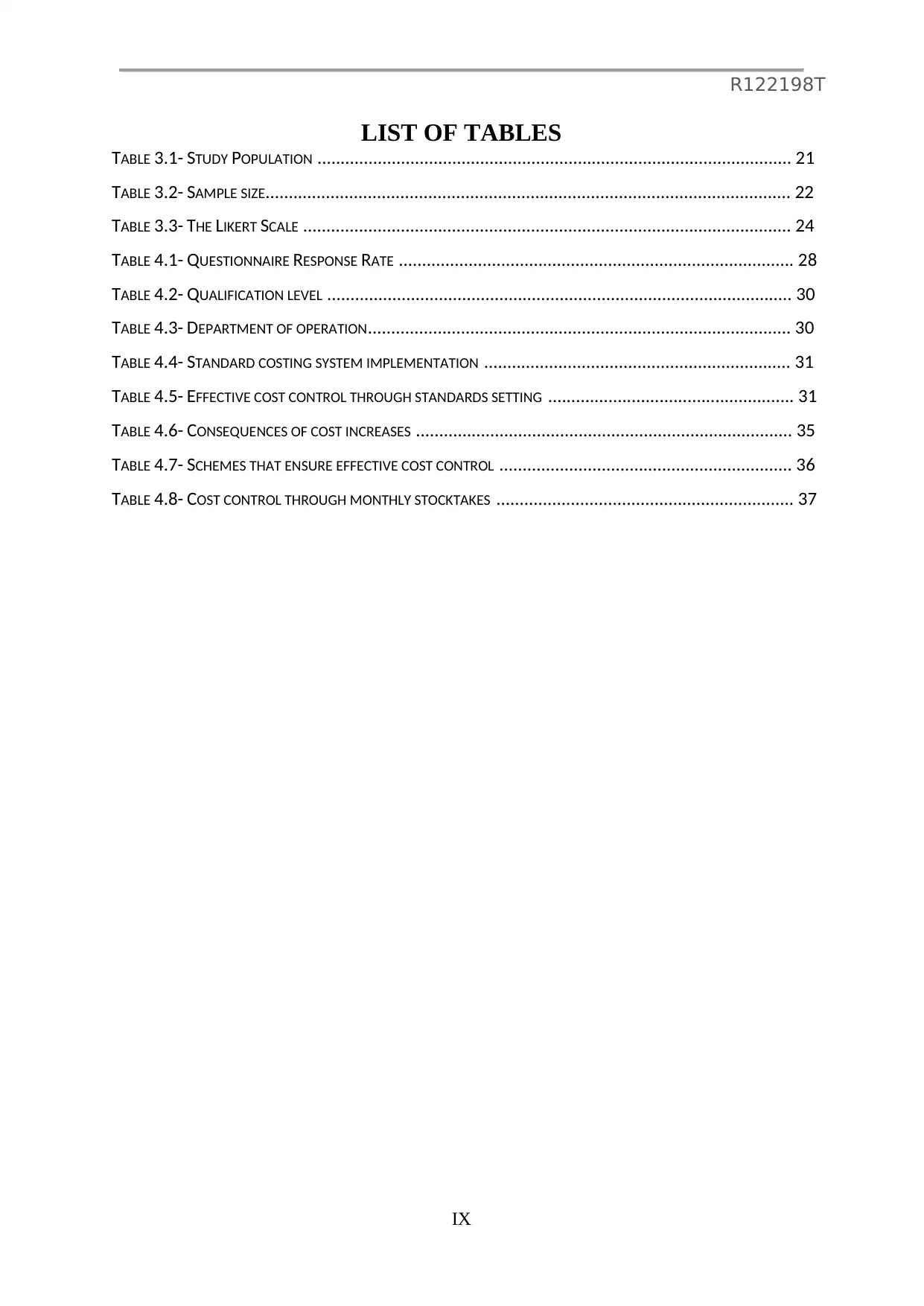
R122198T
IX
LIST OF TABLES
TABLE 3.1- STUDY POPULATION ...................................................................................................... 21
TABLE 3.2- SAMPLE SIZE................................................................................................................. 22
TABLE 3.3- THE LIKERT SCALE ......................................................................................................... 24
TABLE 4.1- QUESTIONNAIRE RESPONSE RATE ..................................................................................... 28
TABLE 4.2- QUALIFICATION LEVEL .................................................................................................... 30
TABLE 4.3- DEPARTMENT OF OPERATION........................................................................................... 30
TABLE 4.4- STANDARD COSTING SYSTEM IMPLEMENTATION .................................................................. 31
TABLE 4.5- EFFECTIVE COST CONTROL THROUGH STANDARDS SETTING ..................................................... 31
TABLE 4.6- CONSEQUENCES OF COST INCREASES ................................................................................. 35
TABLE 4.7- SCHEMES THAT ENSURE EFFECTIVE COST CONTROL ............................................................... 36
TABLE 4.8- COST CONTROL THROUGH MONTHLY STOCKTAKES ................................................................ 37
IX
LIST OF TABLES
TABLE 3.1- STUDY POPULATION ...................................................................................................... 21
TABLE 3.2- SAMPLE SIZE................................................................................................................. 22
TABLE 3.3- THE LIKERT SCALE ......................................................................................................... 24
TABLE 4.1- QUESTIONNAIRE RESPONSE RATE ..................................................................................... 28
TABLE 4.2- QUALIFICATION LEVEL .................................................................................................... 30
TABLE 4.3- DEPARTMENT OF OPERATION........................................................................................... 30
TABLE 4.4- STANDARD COSTING SYSTEM IMPLEMENTATION .................................................................. 31
TABLE 4.5- EFFECTIVE COST CONTROL THROUGH STANDARDS SETTING ..................................................... 31
TABLE 4.6- CONSEQUENCES OF COST INCREASES ................................................................................. 35
TABLE 4.7- SCHEMES THAT ENSURE EFFECTIVE COST CONTROL ............................................................... 36
TABLE 4.8- COST CONTROL THROUGH MONTHLY STOCKTAKES ................................................................ 37
Paraphrase This Document
Need a fresh take? Get an instant paraphrase of this document with our AI Paraphraser
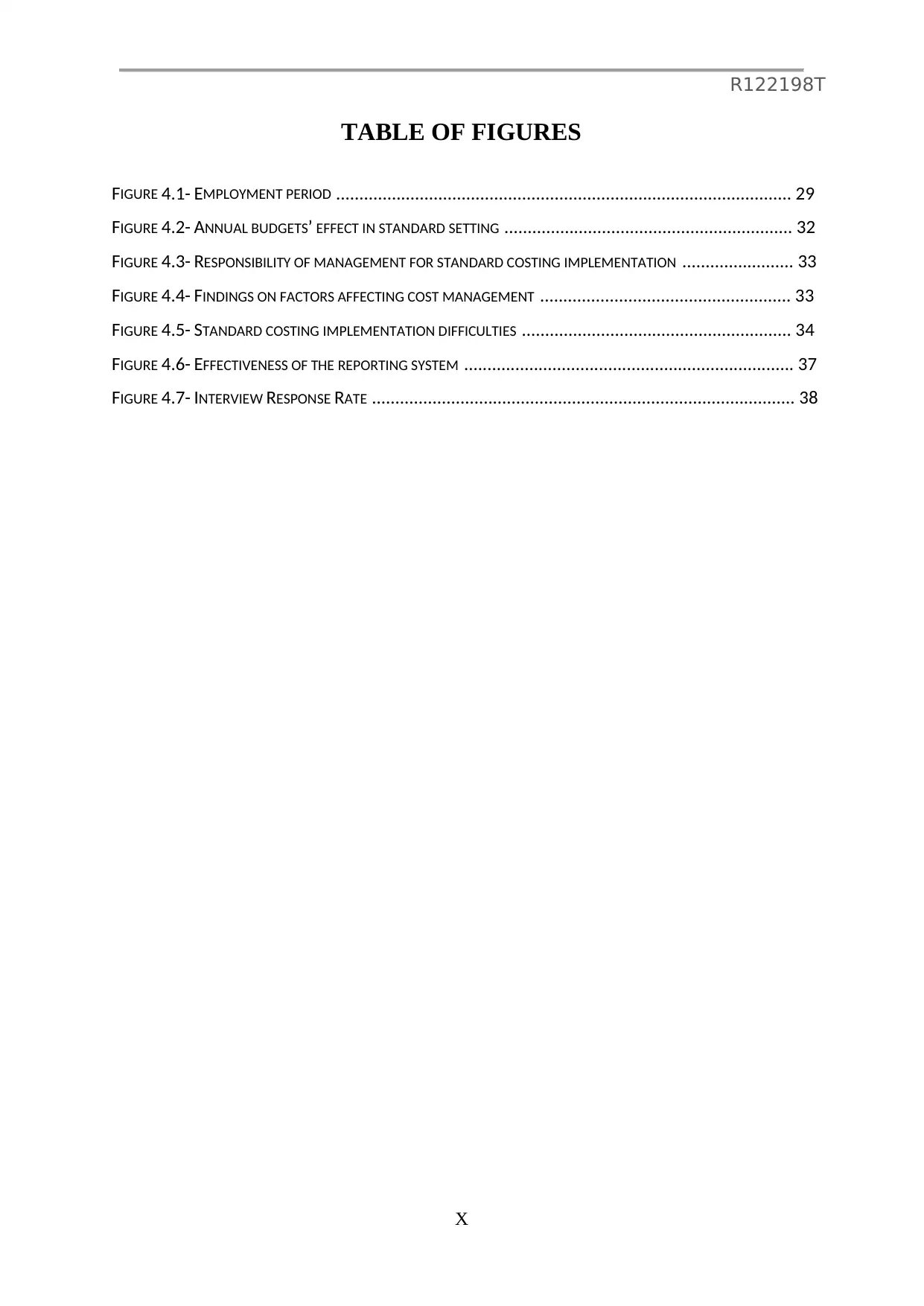
R122198T
X
TABLE OF FIGURES
FIGURE 4.1- EMPLOYMENT PERIOD .................................................................................................. 29
FIGURE 4.2- ANNUAL BUDGETS’ EFFECT IN STANDARD SETTING .............................................................. 32
FIGURE 4.3- RESPONSIBILITY OF MANAGEMENT FOR STANDARD COSTING IMPLEMENTATION ........................ 33
FIGURE 4.4- FINDINGS ON FACTORS AFFECTING COST MANAGEMENT ...................................................... 33
FIGURE 4.5- STANDARD COSTING IMPLEMENTATION DIFFICULTIES .......................................................... 34
FIGURE 4.6- EFFECTIVENESS OF THE REPORTING SYSTEM ....................................................................... 37
FIGURE 4.7- INTERVIEW RESPONSE RATE ........................................................................................... 38
X
TABLE OF FIGURES
FIGURE 4.1- EMPLOYMENT PERIOD .................................................................................................. 29
FIGURE 4.2- ANNUAL BUDGETS’ EFFECT IN STANDARD SETTING .............................................................. 32
FIGURE 4.3- RESPONSIBILITY OF MANAGEMENT FOR STANDARD COSTING IMPLEMENTATION ........................ 33
FIGURE 4.4- FINDINGS ON FACTORS AFFECTING COST MANAGEMENT ...................................................... 33
FIGURE 4.5- STANDARD COSTING IMPLEMENTATION DIFFICULTIES .......................................................... 34
FIGURE 4.6- EFFECTIVENESS OF THE REPORTING SYSTEM ....................................................................... 37
FIGURE 4.7- INTERVIEW RESPONSE RATE ........................................................................................... 38
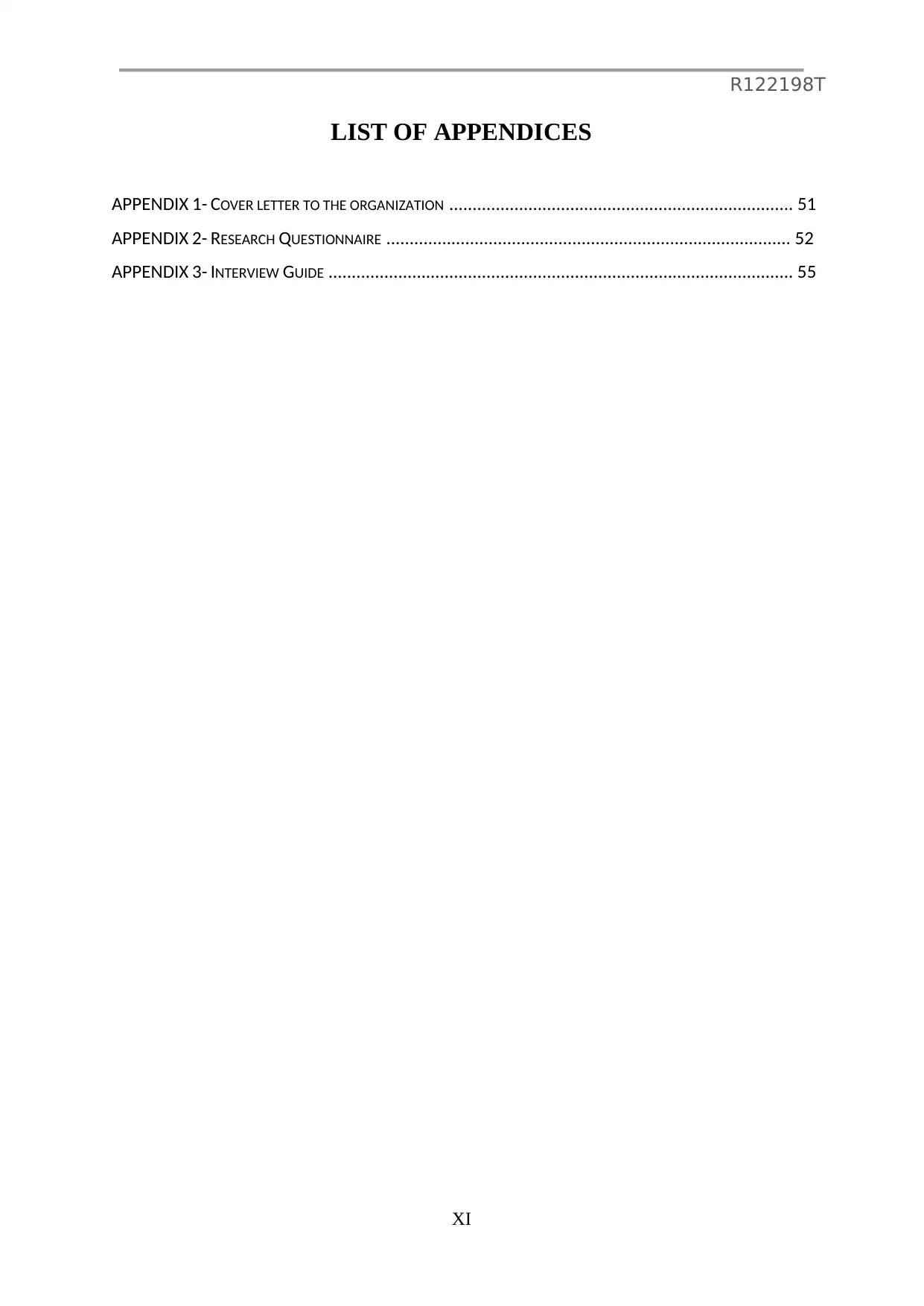
R122198T
XI
LIST OF APPENDICES
APPENDIX 1- COVER LETTER TO THE ORGANIZATION .......................................................................... 51
APPENDIX 2- RESEARCH QUESTIONNAIRE ....................................................................................... 52
APPENDIX 3- INTERVIEW GUIDE .................................................................................................... 55
XI
LIST OF APPENDICES
APPENDIX 1- COVER LETTER TO THE ORGANIZATION .......................................................................... 51
APPENDIX 2- RESEARCH QUESTIONNAIRE ....................................................................................... 52
APPENDIX 3- INTERVIEW GUIDE .................................................................................................... 55
⊘ This is a preview!⊘
Do you want full access?
Subscribe today to unlock all pages.

Trusted by 1+ million students worldwide
1 out of 67
Your All-in-One AI-Powered Toolkit for Academic Success.
+13062052269
info@desklib.com
Available 24*7 on WhatsApp / Email
![[object Object]](/_next/static/media/star-bottom.7253800d.svg)
Unlock your academic potential
Copyright © 2020–2025 A2Z Services. All Rights Reserved. Developed and managed by ZUCOL.